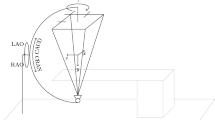Abstract
Current expert-recommended views for coronary angiography are based on heuristic experience and have not been scientifically studied. We sought to identify optimal viewing regions for first and second order vessel segments of the coronary arteries that provide optimal diagnostic value in terms of minimizing vessel foreshortening and overlap. Using orthogonal 2D images of the coronary tree, 3D models were created from which patient-specific optimal view maps (OVM) allowing quantitative assessment of vessel foreshortening and overlap were generated. Using a novel methodology that averages 3D-based optimal projection geometries, a universal OVM was created for each individual coronary vessel segment that minimized both vessel foreshortening and overlap. A universal OVM model for each coronary segment was generated based on data from 137 patients undergoing coronary angiography. We identified viewing regions for each vessel segment achieving a mean vessel foreshortening value of 5.8 ± 3.9% for the left coronary artery (LCA) and 5.6 ± 3.6% for the right coronary artery (RCA). The overall mean overlap values achieved were 8.7 ± 7.9% for the LCA and 4.6 ± 3.2% for the RCA. This scientifically-based OVM evaluation of coronary vessel segments provides the means to facilitate acquisitions during coronary angiography and interventions that minimize imaging inaccuracies related to foreshortening and overlap, improving the accuracy, efficiency, and safety of diagnostic and interventional coronary procedures.





Similar content being viewed by others
References
Popma JJ, Bittl J (2001) Coronary angiography and intravascular ultrasonography. Lippincott Williams and Wilkins, Philadelphia, pp 211–270
Baim DS, William G (2000) Coronary angiography. Williams & Wilkins, Philadelphia
Gibson CM, Ryan K, Sparano A, Moynihan JL, Rizzo M, Kelley M, Marble SJ, Laham R, Simons M, McClusky TR, Dodge JT Jr (1999) Angiographic methods to assess human coronary angiogenesis. Am Heart J 137:169–179. doi:10.1016/S0002-8703(99)70473-4
Deligonal U, Kern M, Roth R (1999) Angiographic data. Mosby, St Louis
Pepine CJ, Lambert C, Hill JA (1994) Coronary angiography. Williams & Wilkins, Baltimore
Green NE, Chen SY, Hansgen AR, Messenger JC, Groves BM, Carroll JD (2005) Angiographic views used for percutaneous coronary interventions: a three-dimensional analysis of physician-determined vs computer-generated views. Catheter Cardiovasc Interv 64:451–459. doi:10.1002/ccd.20331
Chen SJ, Carroll JD (2000) 3-D reconstruction of coronary arterial tree to optimize angiographic visualization. IEEE Trans Med Imaging 19:318–336. doi:10.1109/42.848183
Chen SY, Carroll JD, Messenger JC (2002) Quantitative analysis of reconstructed 3-D coronary arterial tree and intracoronary devices. IEEE Trans Med Imaging 21:724–740. doi:10.1109/TMI.2002.801151
Chen SY, Caroll J (1998) 3-D coronary angiography: improving visualization strategy for coronary interventions. Kluwer Academic Publishers, Dordrecht
Messenger JC, Chen SY, Carroll JD, Burchenal JE, Kioussopoulos K, Groves BM (2000) 3D coronary reconstruction from routine single-plane coronary angiograms: clinical validation and quantitative analysis of the right coronary artery in 100 patients. Int J Card Imaging 16:413–427. doi:10.1023/A:1010643426720
Movassaghi B, Young S, Rasche V (2003) An accurate coronary modeling procedure using 2D calibrated projections based on extracted 3D vessel centerlines. Comput Assist Radiol Surg (CARS 2003):1397–1398
Movassaghi B, Rasche V, Grass M, Viergever MA, Niessen WJ (2004) A quantitative analysis of 3-D coronary modeling from two or more projection images. IEEE Trans Med Imaging 23:1517–1531. doi:10.1109/TMI.2004.837340
Nguyen TV, Sklansky J (1994) Reconstructing the 3D medial axes of coronary arteries in single cine-angiograms. IEEE Trans Med Imaging 13:61–73. doi:10.1109/42.276145
Mourgues F, Devernary G, Malandain G et al (2001) 3D+tModeling of coronary artery tree from standard non simultaneous angiograms. MICCAI:1320–1321
Hoffman KR, Mertz C, Chen SY (1995) Determination of 3D imaging geometry and object configurations from two bi-plane views: an enhancement of the Metz-Fencil technique. Med Phys 22:1219–1227. doi:10.1118/1.597559
Garcia JA, Chen J, Hansgen A, Wink O, Movassaghi B, Messenger JC (2006) Rotational angiography (RA) and three-dimensional imaging (3-DRA): an available clinical tool. Int J Cardiovasc Imaging 23(1):9–13
Garcia JA, Chen SY, Messenger JC, Casserly IP, Hansgen A, Wink O, Movassaghi B, Klein AJ, Carroll JD (2007) Initial clinical experience of selective coronary angiography using one prolonged injection and a 180 degrees rotational trajectory. Catheter Cardiovasc Interv 70(2):190–196 (Epub ahead of print)
Disclosure
John D. Carroll, M.D and S.-Y. James Chen, Ph.D. are Co-inventor of patented 3-D vascular reconstruction and analysis software. The patents have been assigned to the University of Chicago and the University of Colorado. They both received Research grants from Philips Medical Systems.
Author information
Authors and Affiliations
Corresponding author
Rights and permissions
About this article
Cite this article
Garcia, J.A., Movassaghi, B., Casserly, I.P. et al. Determination of optimal viewing regions for X-ray coronary angiography based on a quantitative analysis of 3D reconstructed models. Int J Cardiovasc Imaging 25, 455–462 (2009). https://doi.org/10.1007/s10554-008-9402-5
Received:
Accepted:
Published:
Issue Date:
DOI: https://doi.org/10.1007/s10554-008-9402-5




